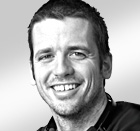The following is the last of three installments about what is design and what is creativity, followed by thoughts on how to create and understand identity — thoughts by SDG’s expert, Helge Tennø.
From insight
The obstacle we are facing in regards to identities is that they are becoming increasingly similar. We are applying too much of the same patterns for exploration; from knowledge to fabrication, and end up with identities that are perceived as the same.
This is the error of the linear “design as a product process”, the one running from analysis to conceptualization, to production and fabrication. Re-engineered by companies into hundreds of variations, but all carrying with it the anchor of working in the wrong direction: the same one as every one else.
This linear model argues that the process of insight ends before the first idea has been conceptualized, that all the questions have been answered before any real ones have been asked. The problem of similar identities does not start with the sketching of ideas; it starts with the structure of exploring knowledge and discovering insight.
Every linear model composes the same problem: It treats the process as machinery, where there is no real exploration of useful material; it is a mechanic (predetermined) process. It assumes that there are no organic components. Which is to say multidimensional components (not unpredictable) that opens the process and takes it on routes that had not been obvious before. But, in the linear process these routes have not been a part of the initial research, they have remained out of sight and are unthinkable/unsolvable in regards to the goal of the brief. It predetermines the path of the solution without even knowing the slightest in regards to opportunities or answers, which is the fault of the linear process.
This is not a case of avoiding responsibility or constructing the platform for never ending incomprehensible processes. This is merely the argument that we need to rethink our processes in order to make them more effective and more useful for the companies employing our services. If the goal is to reap the benefit of an identifiable and unique identity, then we must make sure we are designing an identity, not an addition to a category.
I have the basics of such a design process in mind:
Every project is an exploration of opportunities between a known point: ‘A’ and the known point ‘B’ (a company ‘A’ producing a product ‘B’) – which is understandable. “I’m a bank and I want a new VISA Card identity”, you are not going to design them some branded chopsticks. The problem is that the reign of linear processes guide projects in a direct trajectory between the two points, and every project ends at the same (only incrementally different) identities. The direct trajectory between point A and B is the linear highway of design.
The thing we need to realize though is that ‘B’ is not a geometric point, in fact it’s a large area filled with opportunities, unknowns, more like a big ball than a point. The goal of the design process then is to discover the unseen, and build a process organically to end up within a unique and ownable part of area B. A part which is in line with the identity of A, their customer promise and best possibly suited to understand and meet with empathy the situation where the product offers value.
In an organic mindset what the project needs at its outset is direction, not a steadfast answer in the format of a brief. A Direction is a short document outlining what B is, the company’s ambition and criteria for success. Ready to be signed of with the client, and igniting the team.
The reason is simple: if you fill people with rectangular knowledge they are going to create a rectangle, if you give them the idea that we are building a geometric shape, the whole organism of the team will work together to explore opportunities in the width of geometric shapes.
Photo: Evelyn Glennie, Wikipedia
The grown up mind creates borders where there are none, our processes need to focus less on certainties and more on uncertainties and unknowns. Evelyn Glennie makes the point perfectly as she interacts with the audience and asks them to make soundscapes with her:
“Please clap, and create the sound of thunder … not one of you got out of you seat to think: right, how can I clap? Maybe I can use my jewelry to get extra sounds? Maybe I can use the other parts of my body to create extra sounds? Not a single one of you thought about clapping in a slightly different way other than sitting in your seats there and using two hands…”
After the direction is given it is up to the team to work in increments toward the solution, working visually with prototypes, not schematically with PowerPoint or verbally with Word.
Superbrothers wrote a brilliant article published on BoingBoing on the failure of processes – and the solution, called “Less talk more rock”. In the article they propose jumping hoop over the strategy leg of the process as the team members and the organization lose momentum and enthusiasm by begin dragged through semi abstract articulations of why – not what, and getting right into the playfulness of visualizing and prototyping ideas. (You can always come back to the strategy afterwards they claim).
The Superbrothers’ model not only has the ability of keeping the initial spark alive and growing the organizations interest and dedication to the process, its visual, concrete form also keeps the team more united, the process more inclusive (no language barrier as the solutions are visual) and more fruitful: The visual process nurtures ideas, as soon as a visual prototype hits the table the ideas start to spark.
With this model in place the team is lead by the development of visual prototypes and concepts, and every member of the team works with a common understanding of the goal. In each iteration there is a need for new insight, there are direct and concrete answers to be found, there are changes based on this both in regards to design, logic and identity, which again cultivates new questions. The design/prototype process becomes a string of iterations all serving its own macro eco-system of roles and collaboration.
The result is hopefully a disruptive solution, well within the B area, but in its own niche, breaking away from the sameness of everyone else, but serving the customers and members a better product and the reasons for a more loyal relationship.
As the iterative processes becomes narrower and narrower, and we start finalizing the form, the final stage sets in, the fabrication or implementation of the identity and the product.
Conclusion
Understanding identities means breaking down some stereotypes and admitting that even our own processes and systems needs to be overhauled. It is as difficult for us to look into the void, and take a giant step, as for our clients, who we challenge every day.
We also need to reimburse the value of the terms “design” and “identity”, to articulate the difference between a good design product and mediocre decoration by unskilled hands. We need to include our clients in the articulation of design, if not products will become unsophisticated and conservative (research proves that the will of unarticulated people creates products that people themselves find uninteresting and boring).
And we need to move on; there are limits to how much water could be wrenched out of a dry cloth. It is time to reinvent new ways of finding the next generation of solutions, and so many are already on the right track!
About the Author
Helge Tennø is a planner at Scandinavian Design Group, Norway’s biggest design agency and a part of the McCann World Group. Helge writes an acclaimed blog 180/360/720 and regularly contributes articles and content for printed and online publications. You can read his invaluable presentations here. Helge can also be followed on Twitter — @congbo.

